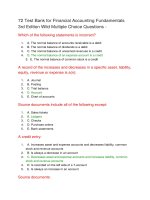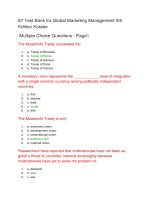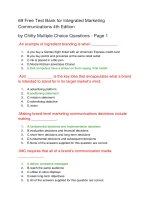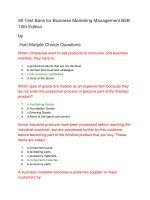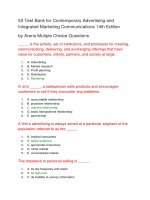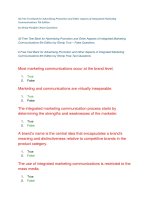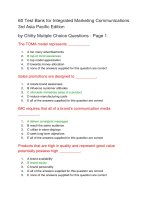50 test bank for integrated marketing communications 3rd edition
Bạn đang xem bản rút gọn của tài liệu. Xem và tải ngay bản đầy đủ của tài liệu tại đây (53.94 KB, 10 trang )
50 Test Bank for Integrated Marketing Communications
3rd Edition
by Tuckwell Mutiple Choice Questions
With demographic segmentation, target markets are identified and p
ursued on the basis of variables such as
1.
2.
3.
4.
5.
A) opinions.
B) age.
C) lifestyle.
D) geographic location.
E) interests.
A form of communications designed to gain public understanding an
d acceptance is called
1.
2.
3.
4.
5.
A) promotional advertising.
B) sponsorship.
C) advertising.
D) goodwill marketing.
E) public relations.
Business buyers buying requirements are typically
1.
2.
3.
4.
5.
A) quality, service, packaging, and price.
B) quality, price, delivery, and continuity of supply.
C) quality, service, continuity of supply,and price.
D) quantity discounts, service, continuity of supply, and price.
E) price, quality, delivery, and storage.
A company that provides differentiated products and services, price
s and delivery strategies for each customer is practising
1.
2.
3.
4.
5.
A) micro-segmentation.
B) psychographic segmentation.
C) direct segmentation.
D) mass marketing.
E) market segmentation.
The new emphasis that business organizations place on customer r
elationship management (CRM)
combined with their ability to manage internal databases, is forcing t
hem toward
1.
2.
3.
A) sales promotion.
B) direct response and interactive communications.
C) sponsorships.
4.
5.
D) promotional advertising.
E) product advertising.
This level of selectivity causes us to screen out messages that confl
ict with previously learned attitudes.
1.
2.
3.
4.
5.
A) selective exposure
B) selective retention
C) selective listening
D) selective perception
E) selective decision-making
An individualʹs favourable or unfavourable feelings toward an idea o
r object are referred to as
1.
2.
3.
4.
5.
A) motives.
B) attitudes.
C) perceptions.
D) needs.
E) impressions.
Lifestyle segments in Canada include the category ʺmavericksʺ. Pe
ople in this group tend to engage
in risky activities, be leaders and seek
1.
2.
3.
4.
5.
A) success.
B) solitude.
C) the respect of the friends.
D) responsibility.
E) influence and power.
Which of the following is not an element of Integrated Marketing Co
mmunications?
1.
2.
3.
4.
5.
A) direct response communications
B) event marketing
C) media advertising
D) packaging
E) sales promotions
A recent survey by the Center for Media Research found that the m
ost important influence for business buyers was
1.
2.
3.
4.
5.
A) the Internet.
B) the Government of Canada.
C) sales promotion.
D) Canadian Institute of Advertising.
E) the advice of others.
Some companies focus on very small yet profitable market segment
s. This is called
1.
2.
3.
4.
5.
A) direct segmentation.
B) micro-segmentation.
C) mini-segmentation.
D) demographic segmentation.
E) homogeneous segmentation.
People born between 1946 and 1964 are and will continue to be a
major buying influence for
decades to come. Another name for this group is
1.
2.
3.
4.
5.
A) the ʺnetʺ generation.
B) the empty nesters.
C) the tweens.
D) the grey market.
E) the baby boomers.
The analysis of information to determine relationships among piece
s of information so that more
effective marketing strategies can be identified and implemented is
called
1.
2.
3.
4.
5.
A) relationship marketing.
B) direct marketing.
C) cluster profiling.
D) data mining.
E) ratio analysis.
Many teenagers purchase products that they think will be perceived
favourably by their friends.
This is an example of the influence of a(n)
1.
2.
3.
4.
5.
A) perception group.
B) reference group.
C) attitude.
D) safety need.
E) ideal self-concept.
A system that collects information about customers for analysis by
managers in order to facilitate sound decisions is called a
1.
2.
3.
4.
5.
A) database management system.
B) P.O.S. system.
C) mailing list.
D) promotional system.
E) direct marketing system.
A restaurant in downtown Vancouver has decided to sell only veget
arian sandwiches. They feel
that this segment will be small, but very profitable. This is an exam
ple of
1.
2.
3.
4.
5.
A) macro-segmentation.
B) target marketing.
C) geographic segmentation.
D) personality marketing.
E) micro-segmentation.
Advertising that provides information about a branded product to hel
p build its image in the minds of customers is
1.
2.
3.
4.
5.
A) predictive advertising.
B) product advertising.
C) attitude advertising.
D) direct advertising.
E) promotion advertising.
Based on what they hear, read and see about a product, as well as
from the opinions of others they have faith in, people form
1.
2.
3.
4.
5.
A) opinions.
B) attitudes.
C) a selective perception.
D) a self image.
E) a personality.
A television commercial for the TD Bank discussing their extended
hours, exceptional customer
service and new web banking offering, is an example of
1.
2.
3.
4.
5.
A) interactive communications.
B) product advertising.
C) customer relationship management.
D) direct response communications.
E) promotional advertising.
In a business buying situation, the __________ are those who contr
ol the flow of information to the members of the buying centre.
1.
2.
3.
4.
5.
A) deciders
B) users
C) gatekeepers
D) controllers
E) influencers
Self-concept theory states that the self has four components. These
are
1.
2.
3.
4.
5.
A) physiological, safety, social, and esteem.
B) real self, self-image, looking-glass self, and ideal self.
C) boomers, gen x, echo boomers, and busters.
D) users, influencers, buyers, and deciders.
E) when, how, why, and who buys.
A decision to invest in mutual funds could be motivated by this need
in Maslowʹs hierarchy.
1.
2.
3.
4.
5.
A) esteem
B) physiological
C) self-actualization
D) social
E) safety
Shoppers Drug Mart often runs newspaper advertisements which in
clude a coupon. This type of advertising is classified as
1.
2.
3.
4.
5.
A) price advertising.
B) promotional advertising.
C) direct response advertising.
D) misleading advertising.
E) product advertising.
Many important consumer decisions are based on
1.
2.
3.
4.
5.
A) the intellectual self.
B) the real and the self image.
C) screened-out messages.
D) significant exposure.
E) the looking-glass self and the ideal self.
A press release issued to newspaper editors by Heinz announcing t
he launch of a new type of ketchup is an example of
1.
2.
3.
4.
5.
A) newspaper advertising.
B) promotion.
C) direct response communications.
D) promotional advertising.
E) public relations.
One of the factors encouraging integrated marketing communicatio
ns is the fact that senior
management likes the idea of __________ results.
1.
A) tangible
2.
3.
4.
5.
B) positive
C) integrated
D) intangible
E) progressive
Many companies devise a separate marketing campaign for Quebe
c. This is an example of
1.
2.
3.
4.
5.
A) geographic segmentation.
B) demographic segmentation.
C) micro-segmentation.
D) psychographic segmentation.
E) provincial segmentation.
All of the following are examples of direct response communications
, except for
1.
2.
3.
4.
5.
A) catalogues.
B) coupons.
C) DRTV.
D) direct mail.
E) telemarketing.
In 2009, Mazda paid to support the Canadian broadcast of ʺSo You
Think You Can Danceʺ on
television. In return, they were allowed to showcase their products
during the show. This element
of Integrated Marketing Communications is called
1.
2.
3.
4.
5.
A) public relations.
B) direct marketing.
C) sponsorship.
D) event marketing.
E) advertising.
A motive is the condition that prompts the action that is taken to
1.
2.
3.
4.
5.
A) determine market segments.
B) satisfy a need.
C) create store displays.
D) design packaging.
E) create an image.
Which of the following phenomena have changed business buying
behaviour the most significantly?
1.
2.
3.
A) mass customization
B) geodemographic segmentation
C) advanced technology and the internet
4.
5.
D) data mining
E) customer relationship management
Sales promotion is used to
1.
2.
3.
4.
5.
A) stimulate an immediate reaction from consumers and distributors.
B) increase advertising dollars.
C) influence the attitudes and opinions of reference groups.
D) increase the product mix.
E) capture information.
Advertising that communicates a specific offer to encourage an imm
ediate response from the target audience is called
1.
2.
3.
4.
5.
A) promotional advertising.
B) integrated marketing communications.
C) direct marketing.
D) product advertising.
E) progressive advertising.
This level of selectivity causes our minds to notice only information t
hat interests us.
1.
2.
3.
4.
5.
A) selective listening
B) selective retention
C) selective exposure
D) selective decision-making
E) selective perception
Air Miles and Canadian Tire money are two examples of
1.
2.
3.
4.
5.
A) customer relationship management programs.
B) sponsorship.
C) loyalty programs.
D) customized programs.
E) both A and C
An analysis of media consumption trends indicates a move away fro
m __________ forms of advertising.
1.
2.
3.
4.
5.
A) traditional
B) interactive
C) integrated
D) personalized
E) electronic
The highest level of Maslowʹs hierarchy of needs is
1.
2.
3.
A) safety.
B) self-actualization.
C) physiological.
4.
5.
D) esteem.
E) social.
The business market has several characteristics that distinguish it fr
om consumer markets, including all of the following except
1.
2.
3.
4.
5.
A) the buying criteria for business buyers are more practical.
B) business buyers are more concentrated.
C) business markets have more buyers.
D) businesses exhibit more ration behaviour.
E) business buyers usually have a formalized buying process.
The identification of target markets according to geographic and de
mographic variables and based
on the assumption that people who live in the same neighborhood s
hare many demographic and lifestyle characteristics is called
1.
2.
3.
4.
5.
A) psychodemographic segmentation.
B) demographic segmentation.
C) psychographic segmentation.
D) geographic segmentation.
E) geodemographic segmentation.
A formal buying structure in an organization that brings together exp
ertise from the various
functional areas to share in the buying decision process is called a
1.
2.
3.
4.
5.
A) buying committee.
B) reference group.
C) target market.
D) market committee.
E) buying centre.
A student will tune out automobile advertising until he graduates an
d can then afford car payments. This demonstrates the theory of
1.
2.
3.
4.
5.
A) self-concept.
B) perception.
C) Maslowʹs hierarchy.
D) repositioning.
E) positioning.
Integrated Marketing Communications involves the coordination of
all forms of marketing
communications in a(n) __________ program that maximizes the i
mpact on the intended target market.
1.
2.
A) long
B) unified
3.
4.
5.
C) exciting
D) unique
E) advertising
Consumer behaviour can be defined as the combined acts carried o
ut by individuals
1.
2.
3.
4.
5.
A) that define mass consumption.
B) when choosing and using goods and services.
C) that are more obvious.
D) that defy logic.
E) that are characteristic of companies.
When Kraft Foods often offers a price discount to large grocery chai
ns to encourage them to
purchase goods in large quantities they are implementing a
1.
2.
3.
4.
5.
A) retailing strategy.
B) pricing adjustment.
C) trade promotion.
D) personal selling option.
E) direct marketing campaign.
All of the following have contributed to the emergence of Integrated
Marketing Communications, except
1.
2.
3.
4.
5.
A) the impact of the internet.
B) the increasing role of traditional advertising.
C) the strategic focus on customer relationship management.
D) the greater demand for efficiency and accountability.
E) the expanding role of database marketing.
A personʹs distinguishing psychological characteristics that lead to r
elative consistent and enduring
responses to the environment in which that person lives is also calle
d their
1.
2.
3.
4.
5.
A) self concept.
B) demographics.
C) self image.
D) personality.
E) ideal self.
Blockbuster Video has a large amount of data collected for each cu
stomer - which videos are
rented, when they are rented, other products purchased with rentals
etc. Recently, a new childrenʹs
DVD was launched and Blockbuster developed a promotional pack
age to send to customers that
had rented two or more childrenʹs videos or DVDs in the past year.
This illustrates the use of
1.
2.
3.
4.
5.
A) database marketing.
B) data mining.
C) demographic segmentation.
D) both A and B
E) lifestyle marketing.
When devising a communications strategy for their new SUV, Jeep f
ocused on the lifestyle and
interests of their target group. This is an example of
1.
2.
3.
4.
5.
A) psychological segmentation.
B) psychographic segmentation.
C) psychosocial segmentation.
D) lifestyle segmentation.
E) demographic segmentation.
An online, business-to-business marketplace through which particip
ants can purchase goods and services from one another is called
1.
2.
3.
4.
5.
A) e-processing.
B) e-marketing.
C) e-prosperity.
D) e-procurement.
E) e-business.
Market segmentation is a three-step process of 1. identifying market
segments by profiling the
primary user 2. selecting the segments that offer the greatest profit
potential and 3.
1.
2.
3.
4.
5.
A) dividing the segment into homogeneous groups.
B) positioning the product so that it appeals to the target segment.
C) designing an ad to appeal to the segment.
D) using demographics to describe the segment.
E) using psychographics to describe the segment.
